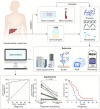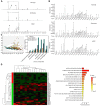Urinary biomarkers for hepatocellular carcinoma: current knowledge for clinicians
- PMID: 37833757
- PMCID: PMC10571477
- DOI: 10.1186/s12935-023-03092-5
Urinary biomarkers for hepatocellular carcinoma: current knowledge for clinicians
Abstract
Hepatocellular carcinoma (HCC) is the most predominant primary liver cancer, causing many illnesses and deaths worldwide. The insidious clinical presentation, difficulty in early diagnosis, and the highly malignant nature make the prognosis of HCC extremely poor. The complex and heterogeneous pathogenesis of HCC poses significant challenges to developing therapies. Urine-based biomarkers for HCC, including diagnostic, prognostic, and monitoring markers, may be valuable supplements to current tools such as serum α-fetoprotein (AFP) and seem promising for progress in precision medicine. Herein, we reviewed the major urinary biomarkers for HCC and assessed their potential for clinical application. Molecular types, testing platforms, and methods for building multimolecule models in the included studies have shown great diversity, thus providing abundant novel tools for future clinical transformation and applications.
Keywords: Biomarkers; Diagnosis; Hepatocellular carcinoma; Multi-omics; Prognosis; Urine testing.
© 2023. BioMed Central Ltd., part of Springer Nature.
Conflict of interest statement
The authors declare no competing interests.
Figures






Similar articles
-
Urine α-fetoprotein and orosomucoid 1 as biomarkers of hepatitis B virus-associated hepatocellular carcinoma.Am J Physiol Gastrointest Liver Physiol. 2020 Feb 1;318(2):G305-G312. doi: 10.1152/ajpgi.00267.2019. Epub 2019 Nov 18. Am J Physiol Gastrointest Liver Physiol. 2020. PMID: 31736338
-
Role of Alpha-Fetoprotein in Hepatocellular Carcinoma Drug Resistance.Curr Med Chem. 2021;28(6):1126-1142. doi: 10.2174/0929867327999200729151247. Curr Med Chem. 2021. PMID: 32729413 Review.
-
PIVKA-II serves as a potential biomarker that complements AFP for the diagnosis of hepatocellular carcinoma.BMC Cancer. 2021 Apr 13;21(1):401. doi: 10.1186/s12885-021-08138-3. BMC Cancer. 2021. PMID: 33849479 Free PMC article.
-
[Research progress of AFP in the diagnosis and therapy of hepatocellular carcinoma].Sheng Wu Gong Cheng Xue Bao. 2021 Sep 25;37(9):3042-3060. doi: 10.13345/j.cjb.210235. Sheng Wu Gong Cheng Xue Bao. 2021. PMID: 34622616 Chinese.
-
Diagnostic and prognostic value of alpha-fetoprotein, des-γ-carboxy prothrombin and squamous cell carcinoma antigen immunoglobulin M complexes in hepatocellular carcinoma.Minerva Med. 2011 Oct;102(5):363-71. Minerva Med. 2011. PMID: 22193346 Review.
Cited by
-
Conduction and validation of a novel mitotic spindle assembly related signature in hepatocellular carcinoma: prognostic prediction, tumor immune microenvironment and drug susceptibility.Front Genet. 2024 Jul 19;15:1412303. doi: 10.3389/fgene.2024.1412303. eCollection 2024. Front Genet. 2024. PMID: 39100078 Free PMC article.
-
Single-Gene Mutations in Hepatocellular Carcinoma: Applications and Challenges in Precision Medicine.Int J Med Sci. 2025 Jul 10;22(13):3268-3276. doi: 10.7150/ijms.117603. eCollection 2025. Int J Med Sci. 2025. PMID: 40765562 Free PMC article. Review.
-
Diagnosis of the Initial Stage of Hepatocellular Carcinoma: A Review.Curr Pharm Des. 2024;30(22):1708-1724. doi: 10.2174/0113816128298875240321073907. Curr Pharm Des. 2024. PMID: 38797901 Review.
-
Sandwich-type supersensitive electrochemical aptasensor of glypican-3 based on PrGO-Hemin-PdNP and AuNP@PoPD.Mikrochim Acta. 2024 May 24;191(6):340. doi: 10.1007/s00604-024-06419-9. Mikrochim Acta. 2024. PMID: 38787447
References
-
- Allemani C, et al. Global surveillance of trends in cancer survival 2000-14 (CONCORD-3): analysis of individual records for 37 513 025 patients diagnosed with one of 18 cancers from 322 population-based registries in 71 countries. Lancet. 2018;391:1023–75. doi: 10.1016/s0140-6736(17)33326-3. - DOI - PMC - PubMed
Publication types
LinkOut - more resources
Full Text Sources

